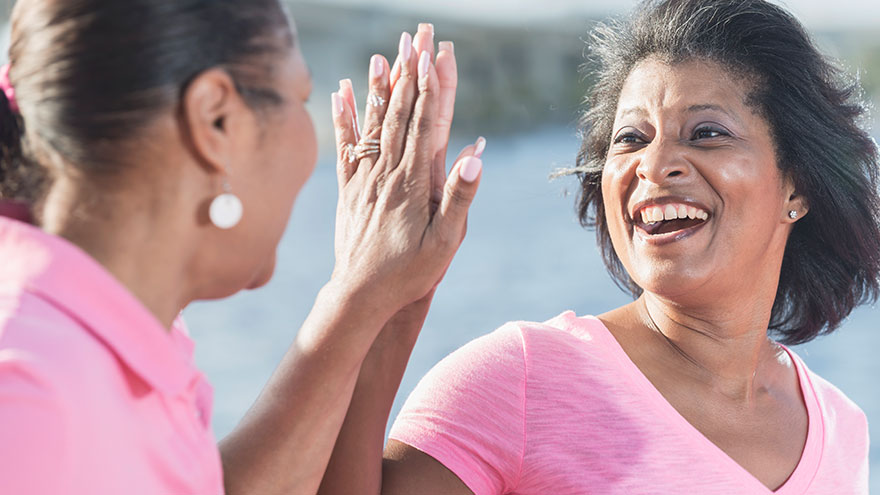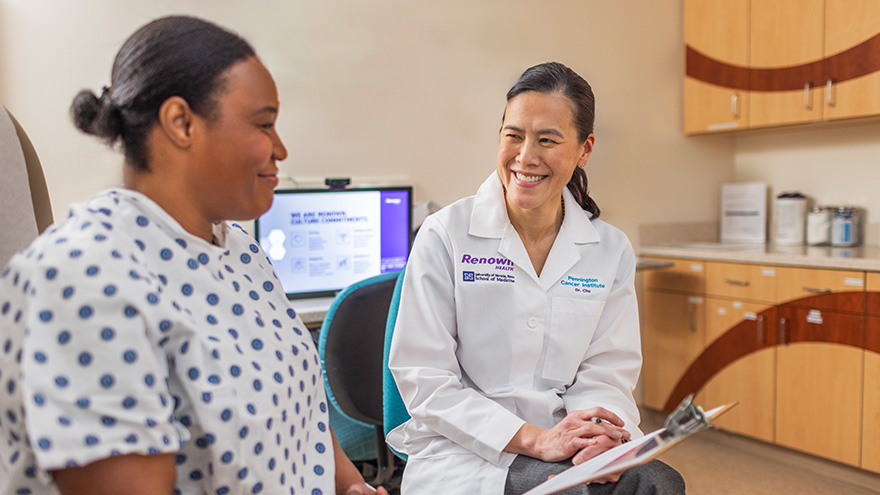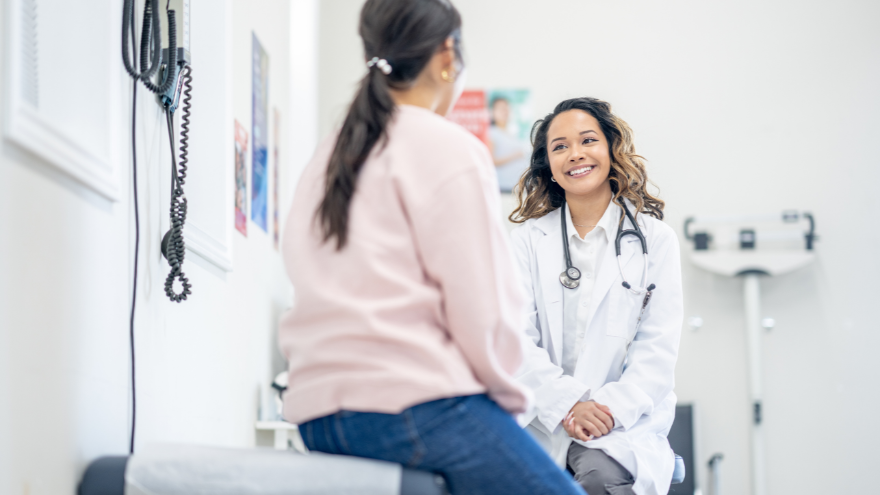Buscar
-
¡Damas! Hágase un examen de detección de cáncer de mama
Early detection is a significant piece of the breast cancer puzzle. Susan Cox, Renown Health Senior Director of Cancer Operations, discusses what you need to watch for and how the latest technology can help detect potential cancer sooner. When should women start getting breast exams? It depends on risk factors: Average-risk women: Most medical organizations recommend the first mammogram between 40 and 44. Higher-risk women: Dependent on their high risk, which will dictate when they start screening, but generally around the age of 30 and not before 25 years old.
-
¿Las mamografías duelen? 4 Mitos desacreditados
Mammograms are an effective means for early detection of breast cancer. Still, many women shy away from them for fear of pain or discomfort. Let us debunk a few mammogram myths that will remove your worries and encourage proactive breast health. Reviewed by Dr. Colleen O'Kelly-Priddy, MD, FACS, breast surgical oncologist at Renown Women's Health. Myth 1: Mammograms Are Painful Reality: Although some women experience discomfort during a mammogram, most say it is not painful. Breast compression, which is important to get a clear image, can cause a sensation of pressure, but this lasts for a few seconds. Let your technician know how much pressure you can handle so you're not uncomfortable. Myth 2: Discomfort Persists Long After the Procedure Reality: The sensation of pressure developed through the compression process diminishes quickly after the procedure. Most women go about their day afterward without experiencing any residual pain.
-
7 Síntomas del cáncer de mama en mujeres jóvenes
Cancer can develop at any age, and that’s why the experts at Renown are ready to help you stay ahead of breast cancer, especially if you're in your 20s or 30s. We're talking about early detection, signs to be aware of, and why being proactive is a big deal. Studies show there has been an increase in breast cancer in younger women. Although breast cancer is rare in women under 40, when it occurs, it tends to be aggressive. The tricky part? Many young women don't think it can happen to them, so they don't check for the signs as often as they should. Reviewed by Dr. Colleen O'Kelly-Priddy, MD, FACS, breast surgical oncologist at Renown Women's Health. Early Signs and Symptoms New or Different Lump in the Breast: A lump is probably the most well-known symptom. Breast cancer is usually painless and firm, but it can also be soft. If you find a new lump, don't panic, but don't ignore it either. Changes in Breast Size or Shape: Have you noticed that one breast looks a little different? Whether it's swelling, shrinking, bulging, dimpling, or seems off, it's worth mentioning to your doctor. Skin Changes: If the skin on your breast starts to thicken or turn red, it's time to pay attention. If your skin starts looking like an orange peel (thickened, with prominent pores), that warrants evaluation. Nipple Discharge: Spontaneous drainage coming from your nipple that isn't breast milk—especially if it's clear or bloody—should be checked out. Nipple Changes: If your nipple starts to invert, flatten, or look different, call your doctor. Breast Pain: Continuous pain in your breast or nipple that isn't linked to your menstrual cycle is another symptom to note. However, breast pain is very common and is only rarely a sign of cancer, so don’t panic. Swelling or Lumps in the Armpit: When it spreads, breast cancer usually first goes to the lymph nodes in the armpit, so swelling or lumps under your arm should be on your radar.
-
Proteja la salud de su hijo con vacunas oportunas
Why are timely vaccinations important? Childhood vaccinations are scheduled and vaccines are administered when young bodies require immediate protection or need to build immunity for diseases and illnesses we may encounter throughout our lives. Delaying recommended vaccinations puts children at higher risk for diseases that can affect them more harshly, like pertussis (whooping cough), which is especially dangerous for babies. Vaccination Benefits Vaccinations save the lives of 1,000s of children (and adults) every year Vaccinations protect us from illnesses that can lead to cancer, hospital stays, life-long health issues & even death Vaccinations help protect those who receive the vaccines and, through herd immunity, also help protect the unvaccinated and seniors whose immunity may have waned. What’s the recommended vaccine schedule for children? In the U.S., we follow the CDC’s vaccine schedule for children and teens up to 18 years of age. The schedule also provides notes regarding missed or late vaccine doses and how to properly “catch-up.” If your child is missing one of the vaccinations listed below, is not quite on-schedule with the recommended timeline or you have any questions regarding vaccines or timings, please reach out to your child’s provider. Vaccine Schedule Birth to 4 Years: Birth – First vaccine for hepatitis B and may receive respiratory syncytial virus (RSV)* vaccine 2, 4 & 6 months of age – Vaccines/boosters for tetanus, diphtheria and pertussis (DTaP), polio (IPV), haemophilus influenza type B (HiB), pneumonia, hepatitis B and rotavirus 6 months to 4 years of age – COVID-19 vaccine, 1-2 doses* 1 year of age – First dose of measles, mumps, rubella with varicella for chicken pox (MMRV) vaccine and boosters for hepatitis A, HiB and pneumonia 15 months of age – 4th dose of DTaP 18 months of age – 2nd dose of hepatitis A 4 years of age – Final dose of MMRV, TDaP and IPV vaccines *Conditions apply. See your child’s provider. Vaccine Schedule 5 Years & Older: CDC and American Academy of Pediatrics (AAP) also recommend the following vaccine schedule for children as they grow: Prior to starting middle school – TDaP and meningitis vaccines/boosters 9-12 years of age – AAP suggests children (and those up to 26 years of age who have not been adequately vaccinated) receive the HPV vaccine to help protect against developing certain cancers as adults Children up to 18 years of age & adults – COVID-19 vaccines are recommended, especially for those with medical conditions such as asthma and diabetes For more vaccination information, please refer to the CDC recommended child and adolescent immunization schedule. Any tips on preparing my child for a vaccination? Many parents worry about side effects like pain and fever for their children after getting vaccinations. Studies have shown that giving Tylenol prior to vaccines can decrease their effectiveness. That’s why providers recommend parents and caregivers wait until after vaccines are administered before giving Tylenol or Ibuprofen, and then only if symptoms develop. Do vaccinations wear off? Many vaccinations provide life-long immunity while others may wear off over time. Vaccines are given to children when they are at most risk for contracting diseases as well as when they are at the highest risk of severe complications from a disease. So even if immunity fades over time, it is important receive vaccinations on time to protect children during these high-risk windows. Doctor's Advice: Ensure Your Child's Health with Timely Vaccinations A child receiving a vaccination can be a scary thing for some parents and misinformation about vaccines on social media and the internet can make things confusing. It is important for parents to discuss any questions they have about vaccines with their child’s health care provider. As medical providers caring for children, we all have the common goal of keeping children the healthiest they can be – and vaccines are an important part of that. To schedule an appointment with a Renown provider, please go here and click here to learn more about Brittany Lemons, MD.
Read More About Protect Your Child’s Health with Timely Vaccinations
-
Conozca al futuro enfermero de Renown Jeromy Hughes
When Jeromy Hughes became one of the 29 nursing students accepted into the first Gerald “Jerry” Smith Academic-Practice Partnership cohort, he almost couldn’t believe it. Life as both an Orvis School of Nursing student and a future nurse in our community was about to change. Not only was he about to receive full tuition support, but he also was set up for a guaranteed start to his career as a nurse at Renown Health. The Academic-Practice Partnership was named in honor of Jerry Smith of the Nell J. Redfield Foundation. Supported by a generous gift from the Redfield Foundation and Stephanie Kruse, Foundation Board Director, the goal of this partnership is to help foster a lasting nursing workforce in northern Nevada, with nurses like Jeromy leading the charge. From the Courtside to the Bedside Jeromy grew up playing basketball in his hometown of Las Vegas and was on the team at Bishop Gorman High School. His talent resulted in a scholarship to play basketball for Wenatchee Valley College in Washington, which would put him on a trajectory to play professionally – even though nursing was always in the back of his mind. Jeromy received a unique opportunity to play for De La Salle University in the Philippines, and with much excitement, he set off across the world. Then, the COVID-19 pandemic hit. When the world shut down, Jeromy had no choice but to stay in the Philippines, waiting to return to the Silver State. Three months later, he flew home to Las Vegas. In those moments, Jeromy’s entire mindset shifted. A career in nursing was no longer in the back of his mind; it came right to the forefront. With a plan to now stay in-state, he set off to attend the University of Nevada, Reno (UNR). “My whole family is involved in the healthcare field, and I’ve always been surrounded by healthcare in some way,” said Jeromy. “My parents own an elder care facility, my dad is a respiratory therapist in Las Vegas and my grandparents own a hospice facility down in southern California. My grandma was also a nurse for more than 50 years, and throughout her career, she worked in labor and delivery, psychiatry and medical-surgical units. I’ve always wanted to help people like my family has, and nursing resonated with me the most out of every option.”
-
Guía para exámenes de detección de cáncer
One of the most crucial aspects of maintaining health and wellness is staying proactive about regular cancer screenings. Early cancer detection significantly increases the chances of successful treatment and survival. The multidisciplinary care team at the William N. Pennington Cancer Institute at Renown Health provides compassionate care and support to the community for early detection and diagnoses. This comprehensive guide outlines the various cancer screenings available for breast, colorectal, lung, cervical, prostate and skin cancer. Breast Cancer Screening Who Should Get Screened? Mammograms are recommended starting age 40 for those considered at average risk for breast cancer. Women with a family history or other risk factors should discuss appropriate screening options with their healthcare provider. Women under 40 with a family history should discuss risk factors with a healthcare provider. Screening Methods Mammogram: This provides an X-ray of the breast and can detect tumors that are not yet palpable. Breast MRI: This type of scan is recommended for women at high risk for breast cancer due to genetic factors or family history. Screening Breast Ultrasound: This scan can help in identifying masses in denser breast tissue that might not be visible on mammogram. It is recommended in addition to a mammogram for patients at a higher risk for breast cancer. What to Expect During a mammogram, the breast is compressed between two plates to capture X-ray images. Some pressure or discomfort may be felt, but the procedure is brief and critical for early detection. Colorectal Cancer Screening Who Should Get Screened? Adults aged 45 to 75 should undergo regular colorectal screenings. Some adults under 45 may need to be screened earlier depending on family history or other genetic risks. Those over 75 should consult with their healthcare provider to determine if continued screening is necessary. Screening Methods Colonoscopy: This procedure uses a flexible tube with a camera to examine the entire colon. Fecal Immunochemical Test (FIT): A non-invasive test that detects hidden blood in the stool. CT Colonography (Virtual Colonoscopy): Uses Computed tomography (CT) imaging to provide detailed views of the colon. What to Expect A colonoscopy can detect changes or abnormalities in the large intestine (colon) and rectum. Screening is usually advised every ten years, but if you are at risk, screening may be recommended every 3 to 5 years after your initial colonoscopy. Colonoscopy preparation includes bowel cleansing the day before and sedation during the procedure. FIT is a simple at-home test requiring no special preparation. Lung Cancer Screening Who Should Get Screened? Adults aged 50 to 80 with a significant smoking history (20 pack years or more) and who currently smoke or have quit within the past 15 years. Screening Methods Low-dose Computed Tomography (LDCT): A CT scan with low radiation doses to create detailed images of the lungs. What to Expect LDCT is a non-invasive scan that requires you to hold your breath for a few seconds. Cervical Cancer Screening Who Should Get Screened? Women aged 21 to 65 should undergo regular screenings. Women aged 21 to 29 should have a Pap test every three years. Women aged 30 to 65 should have a Pap test and HPV test every five years, or a Pap test alone every three years. Screening Methods Pap Test (sometimes called a Pap Smear): Collects cells from the cervix to detect precancers. HPV Test: Identifies high-risk human papillomavirus (HPV) types that can cause cervical cancer. What to Expect The Pap test involves collecting cells from the cervix using a small brush. Some discomfort may be felt, but the procedure is brief and crucial for early detection. Prostate Cancer Screening Who Should Get Screened? Men aged 50 and older should discuss screening options with their healthcare provider. Men at higher risk (African American men and those with a family history of prostate cancer or are a BRCA2 gene carrier) should begin discussing screenings at age 40. Screening Methods Prostate-Specific Antigen (PSA) Test: Measures PSA levels in the blood. Digital Rectal Exam (DRE): A physical examination where the provider feels the prostate through the rectum to detect abnormalities. What to Expect The PSA test is a simple blood test. The DRE may cause slight discomfort but is quick and essential for early detection. Skin Cancer Screening Who Should Get Screened? Anyone with a suspicious lesion or abnormal area on their skin. Individuals with more than 50 moles or dysplastic moles. Those with a personal history of melanoma or history of other skin cancers. Those who have more than one member of immediate family with a history of cancers (melanoma, breast cancer, pancreatic cancer) or a family member who was diagnosed with melanoma before they were 50 years old. Positive gene testing for BRACA2, Lynch syndrome genes (MLH1, MSH2, MSH6, PMS2 or EPCAM). Screening Methods Skin Exam: A visual examination by your provider to check for unusual moles, birthmarks, or other skin changes. Biopsy: Removal of a small sample of skin for testing if an abnormal area is identified. What to Expect A skin exam is non-invasive and visual. A biopsy involves minor discomfort and local anesthesia if needed. Expert Advice Although the cadence of these skin screenings may or may not be annual, as one's age increases, the risk of many cancers rises. Everyone benefits from attentive sun protection, including avoiding direct sun between 10 a.m. and 4 p.m. by seeking shade and wearing hats, clothing and sunscreen. When purchasing sunscreen, look for SPF 50, UVA/UVB broad spectrum. Questions to Discuss with Your Healthcare Provider What is my risk level for different types of cancer? Which screening tests do you recommend for me and why? What are the potential risks and benefits of each test? How often should I get screened? What steps to follow if a test result is abnormal? Importance of Cancer Screenings Regular cancer screenings are vital for maintaining your health and catching cancer early, when it is most treatable. Renown Health is dedicated to guiding you through the process and providing the highest quality of care. Consult with your healthcare provider to determine the appropriate screenings for your specific needs and to take proactive steps toward a healthier future.
-
Cómo proteger a sus hijos de la insolación
With the dangerous heat wave impacting our region, there are heightened risks of heatstroke, especially for children who cannot regulate their body temperature as efficiently as adults. Infants are particularly vulnerable and may not express discomfort, so never leave a child unattended in a vehicle. Top Tips for Preventing Heatstroke Reduce the number of deaths from heatstroke by remembering to ACT. Avoid heatstroke-related injury and death by never leaving a child alone in a car, not even for a minute. And make sure to keep your car locked when you’re not inside so kids don’t get in on their own. Create reminders. Keep a stuffed animal or other memento in your child’s car seat when it’s empty, and move it to the front seat as a visual reminder when your child is in the back seat. Or place and secure your phone, briefcase or purse in the backseat when traveling with your child. Take action. If you see a child alone in a car, call 911. Emergency personnel want you to call. They are trained to respond to these situations Keeping Your Baby Cool in the Back Seat In hot weather, it is crucial to keep your baby cool and hydrated by using a car seat cover or towel over them to reflect the sun's rays. Dress your baby in lightweight clothing that covers their arms and legs. Keep an eye on your baby's skin color. Move them to a cooler place if they look too red or flushed. Keep the temperature at a comfortable temperature for you, not for your child. Keep the windows cracked open for ventilation and ensure nothing is blocking the airflow from entering or exiting the vehicle. Dress your infant appropriately for their environment, including appropriate head and neck coverings, to keep them cool and protected from sunburns. Ensure you have enough fluids to last an hour before getting out of the car or use bottled water if possible. Never leave your child unattended in a car. Steps to Follow if You Suspect Heatstroke Call 911 immediately. Cool the victim – Get the person to a shady area, remove restrictive clothing and cover skin with sheets soaked in ice-water, and place ice packs in the arm pits and groin. Have the victim drink cool fluids, preferably an electrolyte-containing sports drink. Monitor body temperature with a thermometer but stop cooling efforts after temperature has dropped to 102 Fahrenheit. Baby Safe Classes These classes help prepare parents for emergencies that may occur in baby’s first year. Safe Kids Worldwide Did you know heatstroke is the leading cause of non-crash related fatalities in children? “On average, every 10 days a child dies from heatstroke in a vehicle. In more than half of these deaths, the caregiver forgot the child was in the car.”
-
Prevenir el cáncer de piel Consejos de una médica
Want to protect yourself from skin damage from the sun’s harmful rays? Dr. Angela Walker, dermatologist with Renown Medical Group, shares what you can do to prevent skin cancer. What can people do to prevent skin cancer while enjoying the outdoors? There are several steps you can take to protect your skin from the sun. “I caution all of my patients to avoid the sun during the hours of 10 a.m. until 2 p.m. when UV rays are strongest. I also encourage people to wear sleeves on cooler days. And don’t forget that we still need to wear sunscreen on cloudy days! UV rays can still cause sun damage on cloudy days. Preventing skin cancer also entails wearing sunscreen of at least SPF 30 everyday. Are hats also a good idea for skin protection? Yes, of course! Choose a wide-brim hat that shades the face as well as the back of the neck for extra protection against UV rays. When it comes to identifying skin cancer, what should people watch for? We use easy-to-remember letters when checking for spots on the skin; it’s called the ABCDEs: A - Asymmetry: One half of the mole or lesion doesn't match the other half. B - Border irregularity: The edges of the mole are irregular, blurred, or notched. C - Color variation: The mole has different shades of color or uneven color distribution. D - Diameter: The diameter of the mole is larger than the size of a pencil eraser (about 6 millimeters) or is increasing in size. E - Evolution: Any changes in the mole over time, such as size, shape, color, itching, bleeding, or crusting. These guidelines can help in identifying potentially suspicious skin lesions, but it's important to consult a dermatologist for proper evaluation and diagnosis. Early detection is crucial for successful treatment of skin cancer.
-
El Papel de los Ginecólogos Obstetras en la Atención de la Salud de la Mujer
Obstetrician-gynecologists (OBGYNs) see patients from menses (the monthly menstrual cycle that occurs as a part of the female reproductive system), pregnancy and childbirth through menopause and play a pivotal role in managing reproductive health and overall wellness. Dr. James Alexander with Renown Women's Health explains. "As experts in women's health, we are uniquely positioned to recognize subtle changes or symptoms that might indicate broader health issues. This comprehensive approach allows us to serve as a valuable first touchpoint for various health concerns." Preventive Screenings: A Proactive Approach One key aspect is an OBGYN's ability to recommend preventive screenings based on your symptoms, age, lifestyle and medical history. For instance, lipid screenings are critical for monitoring cholesterol levels, which can be a significant factor in women’s heart disease. An OBGYN keeps up with the current guidelines for routine screening as well as in women with risk factors such as high blood pressure, diabetes, or a family history of heart disease during your visit. By identifying risks and abnormal screening early, they can collaborate with you to implement lifestyle changes or treatments to reduce your risk of heart conditions. Schedule Your Screening Appointment Make an Appointment by Phone: 775-982-5000
Read More About The Expanded Role of OBGYNs in Women's Healthcare
-
Comprensión de las razones detrás de los ciclos menstruales pesados
While menstrual cycles can be an annoying inconvenience for many women, heavy bleeding (menorrhagia) is not normal and can disrupt your life. A few days of heavy flow at the start of your period is usually nothing to worry about. However, if you’re frequently experiencing very heavy periods, you should discuss it with your gynecologist or primary care provider. Dr. Megan Fish, an OB-GYN with Renown Women’s Health, discusses various reasons, evaluation and treatment methods when it comes to heavy menstrual cycles. What is classified as heavy menstrual bleeding? The American College of Obstetricians and Gynecologists considers heavy bleeding to be any of the following signs: Bleeding that lasts more than 7 days. Bleeding that soaks through one or more tampons or pads every hour for several hours in a row. Needing to wear more than one pad at a time to control menstrual flow. Needing to change pads or tampons during the night. Menstrual flow with blood clots that are as big as a quarter or larger. What are the most common reasons for heavier periods? A variety of reasons why someone might have heavy periods. Fortunately, most of these problems are treatable. Because each woman's period is unique, only a doctor can definitively determine the cause of your heavy periods. Some of the most common issues that cause heavy periods include: Hormone imbalances such as anovulation, thyroid disease and Polycystic Ovary Syndrome (PCOS). Structural abnormalities in your uterus such as polyps or fibroids. Precancer and cancer such as uterine, cervical, vaginal, ovarian or endometrial hyperplasia. Infections such as chlamydia, gonorrhea, endometritis or vaginitis. Other medical conditions such as liver disease, kidney disease or Pelvic Inflammatory Disease. Medications such as blood thinners and aspirin, hormone replacement therapy, Intrauterine devices (IUDs), birth control pills and injectables. Pregnancy-related problems such as a miscarriage or ectopic pregnancy.
Read More About Understanding the Reasons Behind Heavy Menstrual Cycles
-
Optimización de las mamografías: Un enfoque genético para un cronograma de pruebas de detección personalizado
© Arthon Meekodong via Canva.com Breast cancer screening has long been a cornerstone of women's healthcare. With 1 in 8 women diagnosed with breast cancer in their lifetime1, the United States Preventive Services Task Force (USPSTF) has developed screening recommendations to help detect early-stage cancer. Notably in 2023, the USPSTF revised the recommended age for biennial mammogram screenings for women with average risk to start at age 40 instead of 502, estimated to result in 19% more lives being saved3 by starting screening earlier. While initiating screening at an earlier age offers advantages to a wide demographic, concerns about the potential of over-screening prompted research into the feasibility of identifying women with lower breast cancer risk who could safely delay mammograms. While guidelines address high-risk individuals, a notable gap exists in providing recommendations tailored to those at lower risk. To gain insight into a patient's risk level, physicians are able to utilize genetic testing to understand an individual's genetic makeup, providing precise insights into their predisposition to various health conditions, including breast cancer. Armed with this genetic information, healthcare providers could craft tailored screening strategies that align with an individual’s specific risk profile. This genetic risk-based approach underscores the value of genetics in individualizing the onset of screening to help avoid over-screening and its associated costs. Surprisingly, genetic information is not currently being widely utilized to identify women at risk of breast cancer or other diseases in clinical practice, despite its potential to make a significant positive impact for patients. A recent retrospective analysis of 25,591 women from the Healthy Nevada Project4 sheds light on the potential benefits of this genetic risk-based approach. The study classified 2,338 (9.1%) of these women as having a low genetic risk for breast cancer. What's remarkable is that these women exhibited a significantly lower and later onset of breast cancer compared to their average or high-risk counterparts. This finding suggests that it might be safe for low-risk women to delay mammogram screening by 5 to 10 years without compromising their health.
-
Departamento destacado: Marketing y comunicaciones
Nov. 12-18 is Health Care Strategy & Market Development Week. Please join us in celebrating the Marketing and Communications team at Renown Health! When you think of the brand of Renown Health, what comes to mind? Perhaps you think about our Fight the Good Fight motto that you see integrated throughout our commercials and advertisements. Or maybe your mind drifts to our signature purple that you saw on a print design or social media post. You may even think of a local news story that showcases the essence of who we are as an organization. Or you may gravitate toward the look and feel of our patient-friendly website. Managing the brand of our health system is crucial as patients look to Renown to be the voice of not-for-profit healthcare – and it takes a wide range of expertise to solidify that voice. The masters of our voice can be found within Renown’s Marketing and Communications (“MarComm”) team. From branding and business-to-business to content and community relations, this robust department is the minds behind our reputation within the communities we serve. This team is chock-full of expert writers, speakers, designers and marketers who craft positive and memorable communications that lead to a lifetime of patient and employee loyalty. The Connoisseurs of Communicating As the keyholders of Renown’s brand position and promise, our MarComm team are experts at ensuring the community at large remembers precisely who Renown is and what our health system stands for. This all-hands-on-deck department encompasses a wide variety of talents: Marketing and creative services: Traditional and digital advertising, brand templates and collateral and brand image and awareness Communication and public relations: Employee and provider communications, intranet management, social media, media relations, photography and videography, community relations, crisis communications and strategic planning and advisement Digital specializations: Website and microsites, email marketing, customer journey mapping, blogs and chatbots Our Marketing and Creative Services team members are the ultimate dreamers, starting diverse campaigns from the ground up. “In marketing and creative services, we are always dreaming up something new,” said Emily MacMillan, Manager of Marketing & Creative Services. “Between our brand advertising, to service line campaigns to external partnerships, you can always find our team working on a marketing plan and creating ads, content, messaging, videos, graphics, emails, photoshoots and more.” “From Fight the Good Fight brand work to a service line promotion or a sponsorship creative package, the variety of projects my role allows me to bring to life for Renown is almost endless,” added Chad Norton, Senior Creative Specialist. “That can make every day at my job nothing like the day before – which keeps things interesting and my creativity flowing.” For all things storytelling and public image management, Renown looks to the Communications team for expert guidance. “As the Manager of Communications, I get to lead the most talented group of professionals I have ever had the pleasure of working with,” said Caroline Ackerman, Manager of Communications & Public Affairs. “Sometimes there is an urgent matter to tend to, and we drop everything to support larger-scale communications. Other days, we get last-minute requests from our local media partners for TV interviews. On top of that, the communications team supports event planning and employee recognition. It’s so fun to work in this hybrid space where we can get our work done from home while also being present at meaningful Renown events.” At Renown, we believe our external image is just as vital as our internal culture. Keeping our employees informed and engaged every step of the way is of utmost importance to MarComm. “While most of our department supports projects that focus on our patients, guests and visitors, our employee communications team supports internal clients (our employees),” said Dani Vogel, Communications Business Partner. “Therefore, I spend a good portion of my time working with internal departments and service lines to deliver important communications across the organization using a variety of channels. In a nutshell, my day starts with the question, ‘what do our employees need to know today?’ We get to work with so many amazing internal teams.” “I internally project manage some of the marketing campaigns, from open enrollment to our annual report, and each project is different and requires its own approach,” added Colleen McLellan, Senior Production Specialist. “I create the framework for each project, such as establishing a kickoff and ongoing meeting cadence during the project, ensuring we track lessons learned and decisions made for each, create the folder structure in Sharepoint, and opening a project and maintaining the tasks and deadlines in Workfront. I am also often part of a quality circle, proofing ads and other materials created as part of a campaign. As with all of my colleagues in MarComm, we are often resources for where to learn more or find information for other departments.” “One of my roles is to maintain the Brand HQ site and review approval requests,” added Aurora Boles, Creative Services Specialist. “I enjoy hopping on Teams calls to assist our employees with their questions about the site or templates.” Maintaining a high standard of digital excellence comes easy for the Marketing Technology team, who manage the complexities of Renown’s digital front door – starting with our website. “Think about how many health service lines Renown has to offer; now, let's create an organized set of pages for that specific service line on Renown.org – that a lot of pages!” said Sarah LaBarge, Digital Specialist. “It takes time to curate the layout, work with providers and the Communications team to ensure the content is correct and create components and images for the page to give the user the best digital experience while continually updating and maintaining all our pages. We don't just have Renown.org; we have many other microsites that we maintain as well. It is a nice challenge to make both our team and users happy and have a good experience.” "The user experience is always at the forefront of whatever I do," added Tori Bowlin, Digital Content Editor. "When writing health blogs, emails, or health service web content, it's essential to attribute the information to one of our outstanding providers and link the post to a Renown Health Service or reputable source. A thoughtful workflow helps our customers make informed decisions regarding their health and well-being." As a not-for-profit health system, Renown reinvests right back into the community we serve. Our Community Benefit team serves as the overseers of this promise, ensuring our local non-profits that share our mission are able to deliver on their own goals. “I absolutely love the role of community impact and partnership liaison and the opportunity it provides to work with so many wonderful local nonprofits,” said Melissa Dahir, Community Benefit Liaison. “Our local community is filled with so many organizations designed to help those in need, and it is an honor to be contributing to and supporting the work these amazing groups do. My work with this department involves partnering with nonprofit organizations by providing funding for program support through groups identified in our Community Health Needs Assessment, and providing grants for traditional events such as community walks, golf tournaments, dinners, galas and more.” The MarComm team’s paramount focus on maintaining a caring and collaborative culture stems from the impact they have on patients' lives and the crucial trust placed in the organization. For this team, no project to benefit the health and well-being of Renown’s patients is too big nor too small. “As someone holding a core leadership position on this team, I can see firsthand that our team is all about culture and retention,” said Cristal Woodley, Senior Director of Marketing, Communications and Customer Engagement. “At the end of the day, we have an impact on patients’ lives and trust in the organization. I’ve surrounded myself with such smart people.”
Read More About Department Spotlight: Marketing and Communications











.png?rev=e828eb8f10094f0b887c8c1d418e3db3)